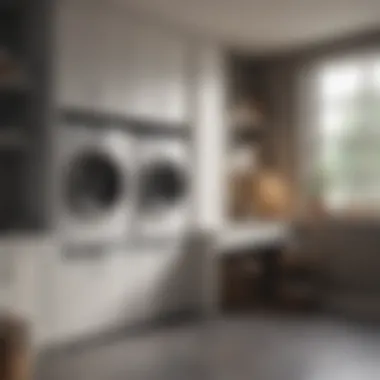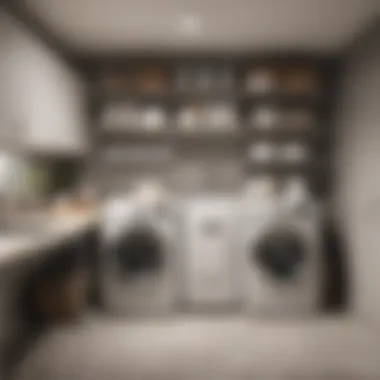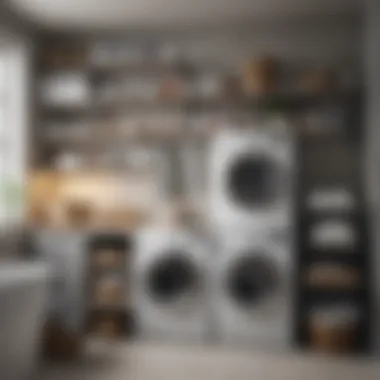Maximizing Laundry Room Shelving Storage Ideas


Intro
Creating an efficient laundry room is essential for many homeowners and renters. The focus often lies in optimizing how we store items in this space, which can quickly become cluttered and disorganized. This article will delve into practical strategies and innovative designs to maximize shelving storage in the laundry room.
We will discuss key considerations for selecting materials, aesthetic choices, and organizational methods. Our goal is to offer insightful information that can transform your laundry area into a functional and visually appealing environment without sacrificing storage capabilities.
Design Inspiration
Current Trends in Interior Design
When planning your laundry room, it is crucial to consider the current design trends. Open shelving has gained popularity for its minimalistic and airy feel. This style allows you to display decorative baskets or folded towels while keeping essential items visible. Additionally, incorporating floating shelves can save floor space and create a seamless look. Using multiple shelf tiers can allow for efficient utilization of vertical space, which is often limited.
Another trend focuses on integrating multi-functional furniture. Laundry islands with built-in storage are quite helpful. They provide a workspace for folding clothes while offering drawers and shelves for supplies.
Color Schemes and Palette Ideas
Choosing the right color scheme can influence the overall feel of your laundry room. Light colors such as soft whites or light pastels create an open atmosphere. However, if you prefer a bolder approach, deep navy or forest green can add elegance. Using contrasting colors between shelves and walls can provide striking visual interest.
Combine colors thoughtfully to match your home's aesthetic. For instance, if your home has a modern farmhouse theme, consider muted tones with natural wood grains to create a cohesive look.
"Well-organized laundry spaces can significantly enhance productivity and elevate the home’s overall aesthetic."
Key Storage Solutions
When optimizing shelving storage, consider various solutions tailored to specific needs. Here are a few to explore:
- Baskets and Bins: Utilize different sizes to categorize laundry supplies, making access straightforward.
- Labeling: Clearly label shelves and bins. This aids in quick retrieval and keeps the space organized.
- Adjustable Shelving: This allows for flexibility. You can modify shelf heights based on your changing storage needs.
- Wall-Mounted Racks: These can hold frequently used items like detergents or fabric softeners, freeing up shelf space.
End
A well-designed laundry room may seem like a luxury, but with careful planning and innovative shelving strategies, it is attainable. Understanding current design trends and selecting appropriate materials can enhance functionality without compromising aesthetics. As you embark on this optimization journey, consider how every inch of space can work to your advantage.
Understanding Laundry Room Storage Needs
Laundry rooms often become a hub of activity in any household. Recognizing their significance and the unique storage requirements is crucial for optimizing such spaces. Adequate shelving storage helps maintain organization, enhances efficiency, and addresses the various needs that arise from daily laundry tasks.
Successful laundry room shelving solutions cater to common challenges including limited space, clutter, and the need for easy access to supplies. By understanding these needs, homeowners can create a functional area that keeps items neatly arranged while ensuring that everything necessary is within reach. Moreover, optimizing storage leads to a more pleasant experience in the laundry area, which is often overlooked compared to other rooms in the home.
Identifying Common Challenges
There are multiple obstacles that homeowners encounter when dealing with laundry room storage. Space constraints often rank among the top challenges. Many laundry rooms are small and designed primarily for utility rather than comfort. This can lead to inefficient use of available space, causing items to pile up, creating a sense of chaos.
Another challenge is varied laundry supplies sizes. From large detergent containers to smaller fabric softeners, each item requires a designated place. Without proper shelving or storage systems, these items may become difficult to locate and organize.
Accessibility is another significant concern, particularly in shared household spaces. Keeping frequently used items easily accessible can streamline the laundry process, reducing time spent searching for supplies. In addition, lack of proper lighting can hinder visibility, further complicating organization.
Understanding these common issues allows for strategic planning into resolving them through effective shelving solutions.
Assessing Available Space
Before selecting shelving options, it is pivotal to assess the available space in the laundry room. Measure the dimensions accurately and consider areas that are often underutilized, such as above the washer and dryer or in corners. The layout must account for door swings and space for movement; each functional element must fit seamlessly into the room's flow.


When sizing shelving, consider not only their height and width but also their depth. Shelves that are too deep may waste space and become hard to reach, while shallower options can allow for easy access to items without overcrowding the space.
Take time to visualize how the shelves will integrate with existing appliances and structures. Drawing a simple layout can provide clarity and help identify potential placement areas. This will ensure that the selected shelving not only serves storage needs but also enhances the overall functionality of the laundry room layout.
In summary, understanding laundry room storage needs is fundamental to creating an effective and organized space. By identifying common challenges and assessing available space, homeowners set the stage for successful shelving solutions.
Criteria for Effective Shelving
In the context of optimizing laundry room storage, the concept of “Criteria for Effective Shelving” encompasses various factors that influence the overall functionality and aesthetic of the space. Effective shelving not only maximizes available storage but also enhances the user experience by addressing practical needs. Understanding these criteria is essential for homeowners who seek both utility and style.
Durability and Material Considerations
Selecting the right materials for laundry room shelving is crucial. The laundry area is often exposed to moisture and heat from appliances, which can affect various materials differently. Thus, choosing durable options can prevent wear and tear over time.
Common materials used for shelving include:
- Plywood: Known for its strength, it can resist bending under weight. A plywood shelf can hold heavier items and withstand moisture if properly sealed.
- Metal: Metal shelving units offer excellent durability and are often resistant to rust. Many come with plastic coatings to enhance longevity.
- MDF (Medium Density Fiberboard): It is cost-effective but may not be as durable in high-moisture areas unless adequately treated.
Considering durability can save homeowners money in the long run, as replacement costs are minimized. It is wise to evaluate frequency of use and the weight of items to be stored when selecting materials.
Weight Capacity and Load Distribution
Understanding the weight capacity of shelving is vital for safety and functionality. Each shelving unit has a limit, and exceeding this can lead to accidents or equipment failure.
To ensure proper weight distribution:
- Consult Manufacturer Guidelines: Always refer to provided specs to avoid overloading shelves.
- Use Corner Brackets: They can help to evenly distribute the weight throughout the unit, especially for heavier items.
- Store Items in a Logical Order: Heavier items should be placed on lower shelves, while lighter items can go higher. This not only maintains balance but also allows easier access when retrieving items.
Important Note: Regularly check shelves for any signs of stress or damage, especially if they hold heavy items. Addressing issues early can prevent larger problems later.
By keeping these weight guidelines in mind, homeowners can create a safe and efficient laundry room. Ultimately, effective shelving should balance aesthetics, durability, and practicality.
Types of Shelving Options
Choosing the right shelving option for your laundry room is crucial. It influences how well you can organize your space and how accessible your items will be. Each option offers unique benefits that cater to different needs and design preferences. Understanding these options can help you configure a functional and appealing laundry room.
Floating Shelves for Minimalist Appeal
Floating shelves are an excellent choice for those who prefer an uncluttered look. They attach directly to the wall without any visible brackets, providing a sense of airiness. This type allows homeowners to showcase decorative items while keeping essential supplies close at hand.
Consider the following when using floating shelves:
- Material Selection: Opt for sturdy materials like hardwood or engineered wood to ensure they can hold weight without warping.
- Installation: Proper installation is essential to support the load. Ensure you secure the shelves into wall studs whenever possible.
- Space Utilization: Utilize the higher areas for infrequently used items, keeping daily essentials at eye level.
- Design Considerations: Choose colors and finishes that complement your broader laundry room aesthetic. Light hues can help open up small spaces.
"Floating shelves are not just functional; they can be a centerpiece in your laundry room decor."
Built-In Cabinet Shelving for Custom Solutions
Built-in cabinets offer a tailored solution for those with specific storage requirements. This option allows for personalized designs that can fit any space perfectly. It can be particularly beneficial in larger laundry areas or when you need additional features like a folding station.
When considering built-in cabinet shelving, keep in mind:


- Custom Design: Work with a designer to create shelving that meets personal needs, whether for additional storage or aesthetic preference.
- Integration: Match the cabinets with existing furniture pieces for a cohesive look.
- Accessibility: Cabinet heights should remain user-friendly. Items should be reachable without straining.
- Lighting: Add interior lighting for visibility in dark spaces, making it easier to find items.
Wire Shelving Units for Versatile Storage
Wire shelving units provide a practical solution for anyone needing flexibility and robustness. These units are often adjustable, allowing users to modify shelf heights based on changing storage needs. Wire shelves are also excellent for ventilation, which can be especially helpful in laundry rooms where moisture is a concern.
Consider these points about wire shelving units:
- Durability: Look for units made from high-grade steel which can handle heavy appliances or numerous supplies without sagging.
- Ease of Cleaning: The open design allows easy access for cleaning. Regular maintenance helps to keep dust and dirt from accumulating.
- Mobility: Many wire shelving units come with wheels, making them easy to move for cleaning or when rearranging the space.
- Accessorize: Utilize bins, baskets, or containers on these shelves to create organization while maintaining visibility.
By understanding the various shelving options available, homeowners can make informed choices that enhance both the functionality and style of their laundry space.
Organizational Strategies for Laundry Rooms
Effective organization in laundry rooms is not just about aesthetics; it is also about maximizing functionality. The laundry room often holds a variety of items—from detergents and fabric softeners to cleaning supplies and tools. By implementing specific organizational strategies, homeowners can ensure that their spaces remain clutter-free and efficient. These strategies include categorizing items, utilizing storage bins, and incorporating hooks. Each approach plays a critical role in creating an environment where everything has its place.
Categorizing Items for Easy Access
Categorizing items based on their use can significantly enhance the functionality of a laundry room. Consider grouping similar items together; for example, cleaning products should be stored in one area, while laundry essentials like detergents and fabric softeners should have their own designated space. This organization not only makes locating items simpler but also minimizes the time spent searching for specific products.
Additionally, consider the frequency of use. Items that are used more regularly should be placed within easy reach, while those needed less often can be stored higher up or in less accessible spots. This not only promotes efficiency but also helps maintain a tidy appearance.
Utilizing Storage Bins and Labels
Storage bins serve as an excellent solution for maintaining organization in a laundry room. They can be used to group similar items and keep them contained, reducing visual clutter. Bins come in various sizes and can fit neatly on shelves or in cabinets. When selecting bins, opt for transparent designs to allow for quick identification of contents.
Labels play a crucial role in this strategy. Proper labeling ensures that every bin is easily identifiable. This simple action encourages all family members to return items to their designated spots. Consider using a label maker or pre-printed labels for a cleaner look. Regularly review and update labels and storage to adapt to changing needs. This adaptability is vital for maintaining an organized space over time.
Incorporating Hooks and Racks
Hooks and racks are versatile tools that can enhance storage space in the laundry room. They provide an opportunity to utilize vertical space that often goes unused. For instance, installing hooks on walls allows for hanging items such as brooms, mops, or towels, keeping them off the floor and readily accessible. This minimizes the risk of clutter and also promotes a safer environment.
Racks can serve multiple purposes, from drying clothes to holding baskets. Look for multipurpose racks that can accommodate various items. These elements can also add to the room's aesthetics, especially when chosen to complement existing decor. With this approach, functionality and design can coexist seamlessly.
Incorporating Aesthetic Elements
In the realm of laundry room design, aesthetic elements play a crucial role alongside functionality. A well-designed laundry room can serve not just as a utility space but also as a reflection of personal style. This section delves into how to enhance the visual appeal of your laundry shelving while maintaining practical considerations. When considering your shelving, think about how aesthetics can elevate the overall experience of doing laundry. A pleasing environment can make tasks feel less mundane and more enjoyable.
Choosing Color Schemes for Visual Appeal
Color schemes can have a profound impact on how a space feels. In a laundry room, choosing the right color palette can transform it from a mere work area into a stylish part of the home. Light colors often create a sense of openness and cleanliness, which is essential in a utility space. Soft whites, pastel blues, and pale greens can brighten the room and make it feel more inviting.
On the other hand, bold colors can add character and make a statement. Dark shades like navy or deep teal can provide a modern touch when used for shelving or accent walls. It is wise to consider how these shades coordinate with the rest of your home. Harmonious color selections tie your laundry room into the overall design of your home.
In addition to color, consider the finish. Matte finishes lend a contemporary feel, while glossy finishes can give an impression of sophistication. When selecting colors, always keep in mind the lighting; natural light versus artificial light can greatly affect how colors are perceived.
Selecting Decorative Accents
Decorative accents are another key aspect of enhancing aesthetic elements. Adding personal touches can make the space feel like your own while also serving functional purposes. For instance, decorative baskets can be visually appealing and practical. They can store various laundry essentials or linens, keeping items organized without compromising style.
Wall art or framed photos can add character to the laundry room. These elements can personalize the space and create warmth. If you have the option, using shelving that can accommodate decorative elements—like books or plants—can also enhance the overall appearance.


Hooks and racks can be both functional and decorative. Choosing attractive hooks for hanging items can maintain organization while also serving as a design feature. They can be positioned at varying heights, also integrating with shelving units.
Incorporating aesthetic elements in your laundry room does not mean sacrificing functionality. When done thoughtfully, your laundry shelving can blend style with usability, making the space not only effective for storage but also visually pleasant to navigate.
Maintaining an Organized Laundry Space
A well-organized laundry space is essential for functionality and efficiency. When items are neatly arranged, it reduces clutter and simplifies the laundry process. An organized environment saves time, prevents frustration, and creates a more pleasant atmosphere. This section discusses steps to maintain an organized laundry area that is both practical and visually appealing.
Establishing a Cleaning Routine
Creating a regular cleaning schedule for your laundry space is vital. This ensures that dust, lint, and detergents do not accumulate over time. You should aim to clean your laundry room weekly or bi-weekly. Here are steps to include in your routine:
- Dust surfaces: Wipe down shelves and counters to remove dust particles.
- Empty trash: Disposing of empty detergent bottles and other waste prevents clutter.
- Organize supplies: Regularly check if laundry supplies are misplaced and return them to their designated areas.
- Inspect appliances: Look for any signs of wear or malfunction in your machines. A quick clean of your washing machine's drum can also improve its longevity.
By establishing a consistent cleaning routine, you enhance the functionality of your laundry space.
Evaluating and Adjusting Storage Solutions
Evaluating storage solutions periodically is crucial for maintaining an organized laundry room. Your needs may change over time, and what worked previously might not be as effective today.
- Assess storage needs: Determine if your current shelving meets your storage requirements. Consider if there are new items you need to accommodate.
- Reorganize regularly: Involve a process to rearrange items, ensuring that frequently used products are easily accessible. Utilize bins and labels to identify contents quickly.
- Upgrade if necessary: If your existing shelving or storage units are inadequate, consider upgrading to more efficient options. Wire shelving units or built-in cabinets may provide better organization.
An organized laundry room can greatly improve the overall experience, making laundry day less of a chore.
Keeping your laundry space tidy not only enhances daily functioning but also contributes to a more enjoyable home environment. By following these steps and maintaining a proactive approach, you can create a truly efficient and organized laundry space.
Closure: Enhancing Functionality and Aesthetics
In the realm of laundry room design, striking a balance between functionality and aesthetics is paramount. The conclusion naturally ties together the various elements discussed throughout the article, reinforcing the idea that an efficiently organized space does not have to compromise on style. When shelving is optimized, it not only serves to store essential items but also enhances the visual appeal, making the laundry experience more enjoyable.
A well-organized laundry room can transform what is often considered a mundane task into a seamless process. Thoughtful shelving solutions allow for better space management, ensuring that each item has its dedicated place. This organization reduces unnecessary clutter, which can create a chaotic atmosphere. Furthermore, shelving that complements the overall color scheme and design theme of the room adds an element of harmony, creating an inviting space.
"A functional laundry room is as much about design as it is about utility."
Moreover, it is vital to consider personal needs and preferences, as these dictate how individuals use their spaces. Customization of shelving installations to suit specific requirements can increase both convenience and satisfaction. Overall, the conclusion emphasizes that merging functionality with aesthetic choices leads to a laundry room that is not only practical but also visually pleasing.
Reflecting on Personal Needs and Preferences
To truly optimize laundry room shelving, one must begin by evaluating personal needs and preferences. Each household is unique, and what works for one might not necessarily work for another. Understanding how the laundry room is used can inform shelving design choices, ultimately enhancing efficiency.
Consider the items typically stored in the laundry room. Are you frequently washing large blankets, or do you have a collection of delicate garments? Do you require storage for cleaning supplies, or do you need space for craft materials? Taking inventory of these items will significantly shape the shelving setup.
Once a clear picture of your needs is painted, it’s worthwhile to think about height and accessibility.
- Tall shelves may help free up floor space but might not be the best if reaching them proves challenging.
- Lower shelves provide ease of access but could be less efficient in utilizing vertical space.
Additionally, integrating personal preferred styles into shelving choices is essential. For instance, those who favor rustic designs might choose wooden shelves finished in warm tones, whereas modern preferences could call for sleek, minimalist shelves made of metal or glass. Reflecting on personal aesthetics fosters a cohesive look in the laundry room, turning it into a space that feels tailored just for you.
Encouraging Continuous Improvement
Maintaining an organized and aesthetically pleasing laundry room is not a one-time effort; it is an ongoing process. Encouraging continuous improvement in shelving storage can lead to better functionality over time.
Regularly reassessing how shelving is utilized is key. As lifestyles change, so do needs. For instance, as children grow, their laundry requirements may shift, or new cleaning products may come onto the market. By routinely evaluating storage solutions, one can adapt the space to current needs, avoiding stagnation.
Moreover, consider adopting a routine that allows for seasonal reviews. Every few months, evaluate the contents of your shelving and determine if reorganization is necessary. This periodic check can help in identifying clutter and understanding what items are no longer useful, ensuring that minimalism is practiced effectively.
Finally, gather feedback from other family members or users of the laundry space. Each individual may have insights about how to optimize shelving storage that you might not have considered. Engaging in discussions can unveil fresh perspectives, leading to further enhancements.



